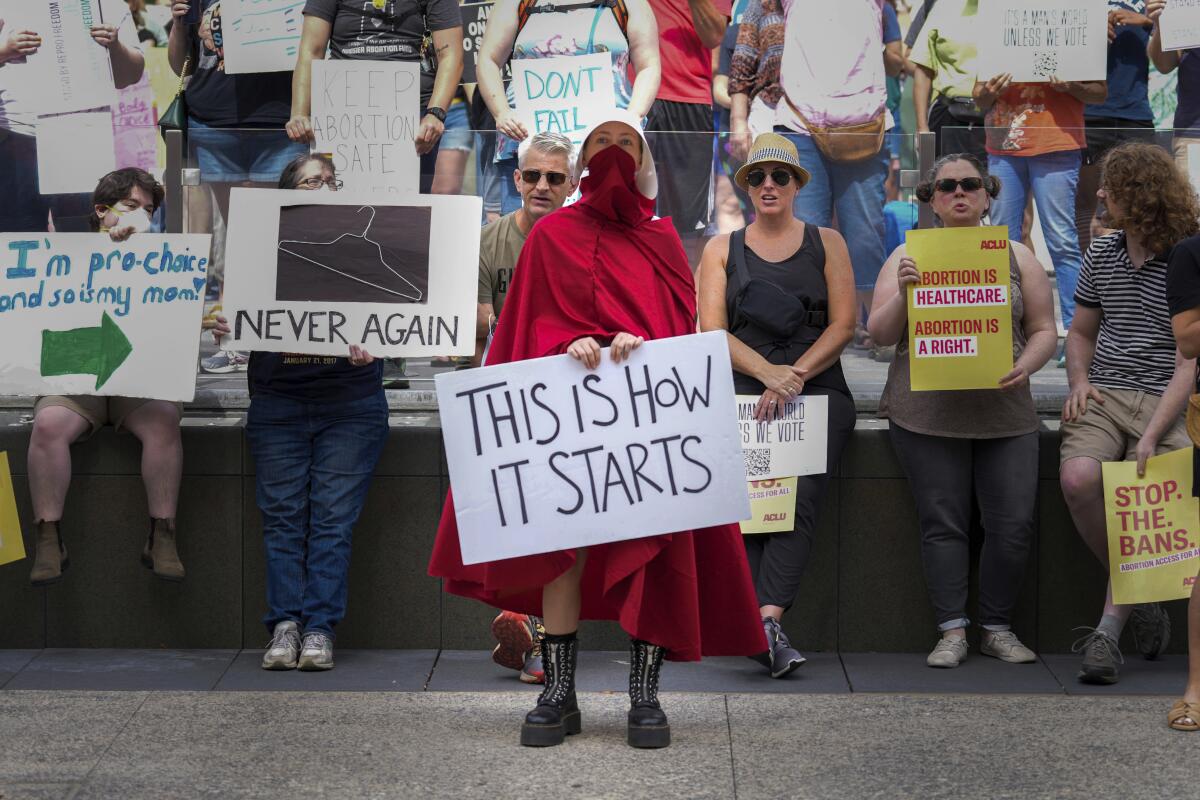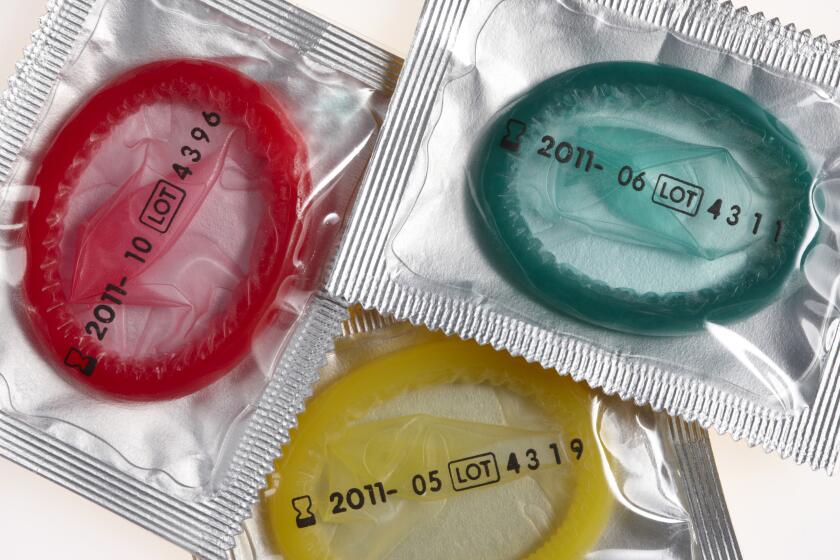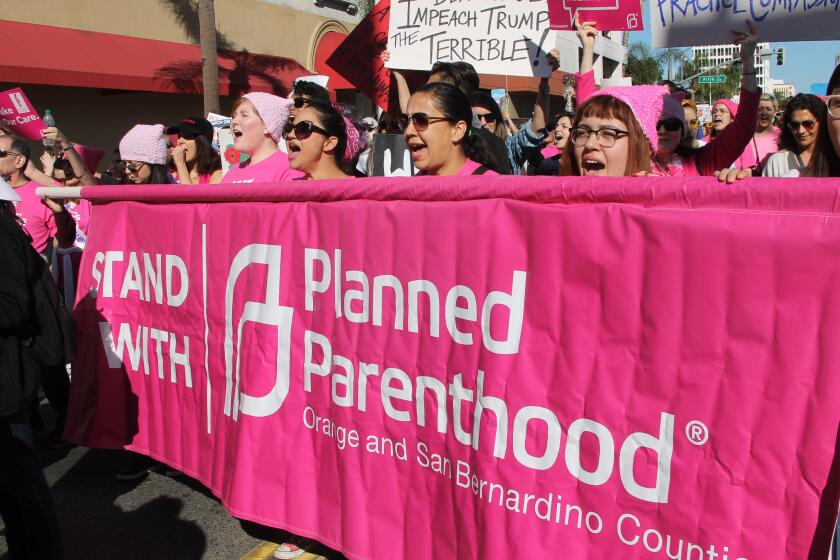Column: Desperate abortion foes resort to new tactics while pregnant people find ways to thwart them

Illegal abortion is back, and — dare I say? — it’s better than ever.
Did our ultraconservative Supreme Court, so out of step with 21st century America, really think that overturning nearly 50 years of legal precedent would end elective abortion in America?
Sure, sure, they returned the issue to the states, the reddest of which immediately banned the procedure, even when a pregnancy results from rape or incest or the fetus has medical issues incompatible with life.
But did the court’s six-justice supermajority, blinded by its own cruelty, fail to realize that overturning Roe vs. Wade would catalyze a new kind of underground railroad, where people with access to medications that end pregnancies would create support networks to connect patients with pills?
How cruel is the court? Justice Amy Coney Barrett suggested that forcing a woman to keep an unwanted pregnancy, undergo labor and delivery, then give the baby up for adoption was a perfectly reasonable alternative to abortion. I’m still not over that one.
Turns out the midterm elections last month underlined something we already knew: Most Americans support a woman’s right to choose. In the five states where abortion was on the ballot, voters overwhelmingly protected reproductive rights.
Not only that, but the abortion issue played a big part in the historic success of Democrats in the midterms, where the party in power is generally subjected to a political shellacking.
The failure of the GOP to win back the Senate in November and its relatively feeble new majority in the House can be blamed, partly, on the court overturning Roe. A post-vote analysis by the Kaiser Family Foundation and the Associated Press found that while inflation weighed heavily on voters’ minds, the issue of abortion drove many votes, including among young voters, whose turnout was higher than it’s been in three decades.
Roe, Roe, Roe the vote? Oh, hell yes.
Abortion foes, who were dancing in the streets only a few months ago, are now starting to sound a little desperate. “While abortion rights advocates appear largely united in their approach,” reported the Washington Post last week in a story about efforts to further stymie abortion access, “the rise of abortion pills and the election results have combined to highlight tensions over what to do next.”
Abortion foes refuse to accept that men are responsible for unwanted pregnancies, and therefore for abortions.
Sure, the forces arrayed against abortion have managed to throw up plenty of unconscionable and effective barriers, but they are finally having to admit that women will always find ways to end pregnancies, even if they have to break laws to do it.
Medication abortions now account for more than half of all abortions in the country. Pills, a combination of the drugs mifepristone and misoprostol, can arrive in the mail, even in states where abortion is illegal. Medical personnel may be involved to some degree, but they need not be.
As a result, abortion has moved, in most cases, from the clinic to the privacy of one’s own home. Can you imagine how this flips out the right-to-lifers?
Abortion-hostile Texas is in the forefront of efforts to throw up new obstacles to reproductive freedom and, incidentally, freedom of speech. Lawmakers there want to force internet providers to block access to abortion pill websites and online pharmacies, the way child porn sites are blocked.
“Everyone who is trafficking these pills should be in jail for trafficking,” Marjorie Dannenfelser, president of Susan B. Anthony Pro-Life America, told the Post. “It hasn’t happened, but that doesn’t mean it won’t.”
As the ever-creative minds who oppose abortion reach for even weirder ways of thwarting women, they are now masquerading as environmentalists.
Students for Life of America, an antiabortion group that claims to have a presence on more than 1,000 American campuses, has argued without proof that medication abortions are bad for the environment. And last month, the group petitioned the FDA, asking it to require that fetal remains be treated as medical waste, rather than flushed down the toilet.
The pair who posed as biomedical professionals in a failed effort to entrap Planned Parenthood will pay a hefty price for their illegal acts.
Environmental experts find the prospect absurd. “Of all the drugs and synthetic chemicals we shed that can potentially contaminate water, abortifacients are a fraction of a fraction of a percent,” one environmental scientist told Politico last month. “It’s nothing.”
Meanwhile, conservative pundits have been working overtime to try to convince the electorate, which overwhelmingly supports abortion rights, that the Supreme Court was right, and that letting a woman make her own choices about her reproductive fate is bad for her, bad for men and bad for society.
Abortion, the argument goes, disincentivizes marriage, commitment and two-parent families, which seems a particularly retrograde view of modern American life.
“Does American Society Need Abortion?” asked the headline on conservative New York Times pundit Ross Douthat’s column last week.
Apart from the obvious, glib answer — no, American society doesn’t need abortion, individual women do — all you have to do is recall what women went through before the Supreme Court legalized abortion in 1973. Those were days when those with unwanted pregnancies, including my mother and my grandmother, were forced to seek back-alley abortions, which could be expensive, terrifying and, in many cases, deadly.
We may live in a world where a legal right has been unconscionably wrenched from women by a misguided Supreme Court. But we also live in a world, thank God, where newly illegal abortions are safer than ever.
More to Read
A cure for the common opinion
Get thought-provoking perspectives with our weekly newsletter.
You may occasionally receive promotional content from the Los Angeles Times.














